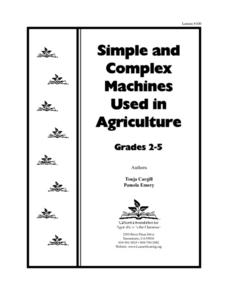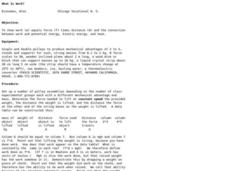Purdue University
The Represented World: Recreational STEM
How are forces and motion important to a swing set? Scholars explore the concepts of force and motion using swing sets. In preparation for their own STEM design project, individuals take surveys and data from peers, complete labs on...
Curated OER
Engineering: Simple Machines
Fourth graders participate in activities to examine how simple machines help build things. They identify the six types of simple machines. They discover how simple machines where use historically to build pyramids and how they are still...
Curated OER
Crash Test Dummies
Fifth graders are introduced to Newton's First Law of Motion. In groups, they describe the differences between balanced and unbalanced forces. They participate in experiments that demonstrate how equal and opposite forces act upon...
Purdue University
Simple Machines
What's the best way to use a simple machine to solve a real-world problem? Scholars construct their own simple and complex machines to explore the concepts of work and force. They discuss examples of simple machines they have found in...
Curated OER
Simple and Complex Machines Used In Agriculture
Students explore agriculture and the current technologies and research that continue to make Earth a viable planet. This four lessons unit introduce students to simple machines and the concepts of force and friction through a variety of...
Curated OER
Steep, Steeper, and Steepest
Fifth graders discuss ways to move large rocks. They relate this to building a rock garden, and the ways people might load boulders into a truck. Students discuss the use of a ramp vs. lifting the boulder straight up onto the bed of the...
Curated OER
Force And Motion With Cars
Students discover that different things move at different speeds. They compare the distance a car travels on a ramp with and without a push. They
push the car with one finger the first time, let it move without a
push the next time (no...
Curated OER
Force and Motion Flip Books
Fourth graders identify six simple machines in real world examples, distinguish between the three different types of levers and explain Newton's three laws of motion. They create a multimedia presentation over the information they've...
Curated OER
Changes in Force, Motion, and Energy
Eighth graders construct various machines and compare the work done by them.
Curated OER
Getting Help, but for More Work?
Fifth graders discuss prior knowledge of slope and force. They relate steepness of slope to the force needed to get an object up the slope. Students read from their text the information about inclined planes. They answer the questions...
Physics Classroom
All Work and No Play Lab
Don't let the term, "slotted wood board" detract you from the value of this experiment. Class members tie a string to a cart and, with even horizontal force, drag it up an inclined plane. The objective is to compare the work done with...
Curated OER
Acceleration Lab
Young Einsteins experiment with the acceleration of Hot Wheels™ toy cars down inclined planes at various angles. This classic physics lab activity is thoroughly explained in both a teacher’s guide and a student lab sheet. Science...
Scholastic
Study Jams! Simple Machines
Here is a tri-faceted resource that has a slide show, a quiz, and a vocabulary list that you can use to teach simple machines. Six machines are introduced: wheels and axles, planes, levers, pulleys, wedges, and screws. Slides contain...
Curated OER
Machines
In this machines worksheet, students review different types of simple machines including pulleys, wedges, levers, and inclined planes. This worksheet has 10 matching, 4 multiple choice, and 8 short answer questions.
Curated OER
What is Work?
Students investigate the connection between work, potential energy, kinetic energy, and heat. In this physics lesson plan, students use pulleys to produce mechanical advantages and incline planes to demonstrate energy conversion.
Curated OER
Forces That Move Objects
In this forces worksheet, students complete a graphic organizer by writing in examples of simple machines that can apply forces to move objects.
Curated OER
Simple Machines
Here is an inventive plan that should get your young scientists excited! In it, groups of pupils test out the work done by six different simple machines. The machines are: the wedge, the lever, the inclined plane, the pulley, the screw,...
Curated OER
Simple Machines
In this simple machines worksheet, students identify the 6 simple machines. They answer 21 questions about the types of simple machines, the output force of simple machines, the input force and the work involved in using a simple machine.
Curated OER
Work and the Farm
Students listen to a lecture by the teacher about farm work and ways to use physics to make farm work easier. The machines that are highlighted include pulleys, ramps, lever, and gears. Each machine is explained in context of its use in...
Alabama Learning Exchange
Investigating Friction
Young learners explore friction. They view a video or DVD (bibliography provided) and define terms related to friction, and work in groups to experiment with the effects of friction on speed and motion using ramps and toy cars.
Colorado Unit Writing Project
Simple Machines
Planning an elementary science unit has never been simpler! These twelve lessons guide young scientists through an exploration of simple machines and their many uses in the real world before asking them to apply their learning...
Norwich Institute for Language Education
Simple Machines
Planning a unit on simple machines? Save some time and energy with this collection of lessons and activities that explores how these devices are used in the real world to make life a little easier.
Curated OER
Simple Machines
Students investigate simple machines. In this simple machines lesson, students explore how tools increase productivity and make life easier. Students experiment with simple tools and discover the parts of each tool.
Curated OER
Simple Machines Worksheet
In this simple machines worksheet, students match the simple machine to its definition. Students then identify the pictures by the type of machine it represents. This worksheet has 6 matching and 12 fill in the blank questions.























